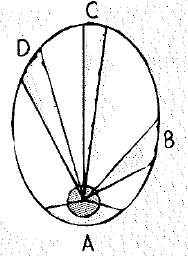
Kepler tells us that a planet sweeps out equal areas in equal intervals of time. Four such equal-area ’triangles' are shown.

Rank these quantities from greatest to least.
a. average speed during the time interval
b. acceleration during the time interval
(a)
To Rank: Average speed during the time interval from greatest to least.
Answer to Problem 23A
A > B > D > C.
Explanation of Solution
Introduction:
Since the planet sweeps out equal areas in equal amounts of time, the planet has to travel faster along a bigger arc and slower along a smaller arc.
The average speed of the planet is greater when the planet has to sweep a bigger arc.
Therefore, the average speed ranking is A > B > D > C.
(b)
To Rank: The acceleration during the time interval.
Answer to Problem 23A
A > B > D > C
Explanation of Solution
Introduction:
Acceleration is the change in velocity with respect to time.
While following an arc, the planet can change its direction from positive to negative, or vice versa.
The change in velocity for a bigger arc would be greater than for a smaller arc. Thus, the acceleration is the highest for the longest arc.
Hence, the ranking is A > B > D > C.
Chapter 14 Solutions
Conceptual Physics: The High School Physics Program
Additional Science Textbook Solutions
Campbell Biology in Focus (2nd Edition)
Chemistry (7th Edition)
Microbiology: An Introduction
Microbiology: An Introduction
Human Anatomy & Physiology (2nd Edition)
College Physics: A Strategic Approach (3rd Edition)
- please answer this asap!!!!arrow_forwardRT = 4.7E-30 18V IT = 2.3E-3A+ 12 38Ω ли 56Ω ли r5 27Ω ли r3 28Ω r4 > 75Ω r6 600 0.343V 75.8A Now figure out how much current in going through the r4 resistor. |4 = unit And then use that current to find the voltage drop across the r resistor. V4 = unitarrow_forward7 Find the volume inside the cone z² = x²+y², above the (x, y) plane, and between the spheres x²+y²+z² = 1 and x² + y²+z² = 4. Hint: use spherical polar coordinates.arrow_forward
 College PhysicsPhysicsISBN:9781305952300Author:Raymond A. Serway, Chris VuillePublisher:Cengage Learning
College PhysicsPhysicsISBN:9781305952300Author:Raymond A. Serway, Chris VuillePublisher:Cengage Learning University Physics (14th Edition)PhysicsISBN:9780133969290Author:Hugh D. Young, Roger A. FreedmanPublisher:PEARSON
University Physics (14th Edition)PhysicsISBN:9780133969290Author:Hugh D. Young, Roger A. FreedmanPublisher:PEARSON Introduction To Quantum MechanicsPhysicsISBN:9781107189638Author:Griffiths, David J., Schroeter, Darrell F.Publisher:Cambridge University Press
Introduction To Quantum MechanicsPhysicsISBN:9781107189638Author:Griffiths, David J., Schroeter, Darrell F.Publisher:Cambridge University Press Physics for Scientists and EngineersPhysicsISBN:9781337553278Author:Raymond A. Serway, John W. JewettPublisher:Cengage Learning
Physics for Scientists and EngineersPhysicsISBN:9781337553278Author:Raymond A. Serway, John W. JewettPublisher:Cengage Learning Lecture- Tutorials for Introductory AstronomyPhysicsISBN:9780321820464Author:Edward E. Prather, Tim P. Slater, Jeff P. Adams, Gina BrissendenPublisher:Addison-Wesley
Lecture- Tutorials for Introductory AstronomyPhysicsISBN:9780321820464Author:Edward E. Prather, Tim P. Slater, Jeff P. Adams, Gina BrissendenPublisher:Addison-Wesley College Physics: A Strategic Approach (4th Editio...PhysicsISBN:9780134609034Author:Randall D. Knight (Professor Emeritus), Brian Jones, Stuart FieldPublisher:PEARSON
College Physics: A Strategic Approach (4th Editio...PhysicsISBN:9780134609034Author:Randall D. Knight (Professor Emeritus), Brian Jones, Stuart FieldPublisher:PEARSON





